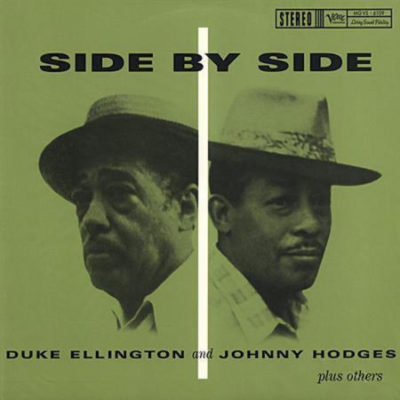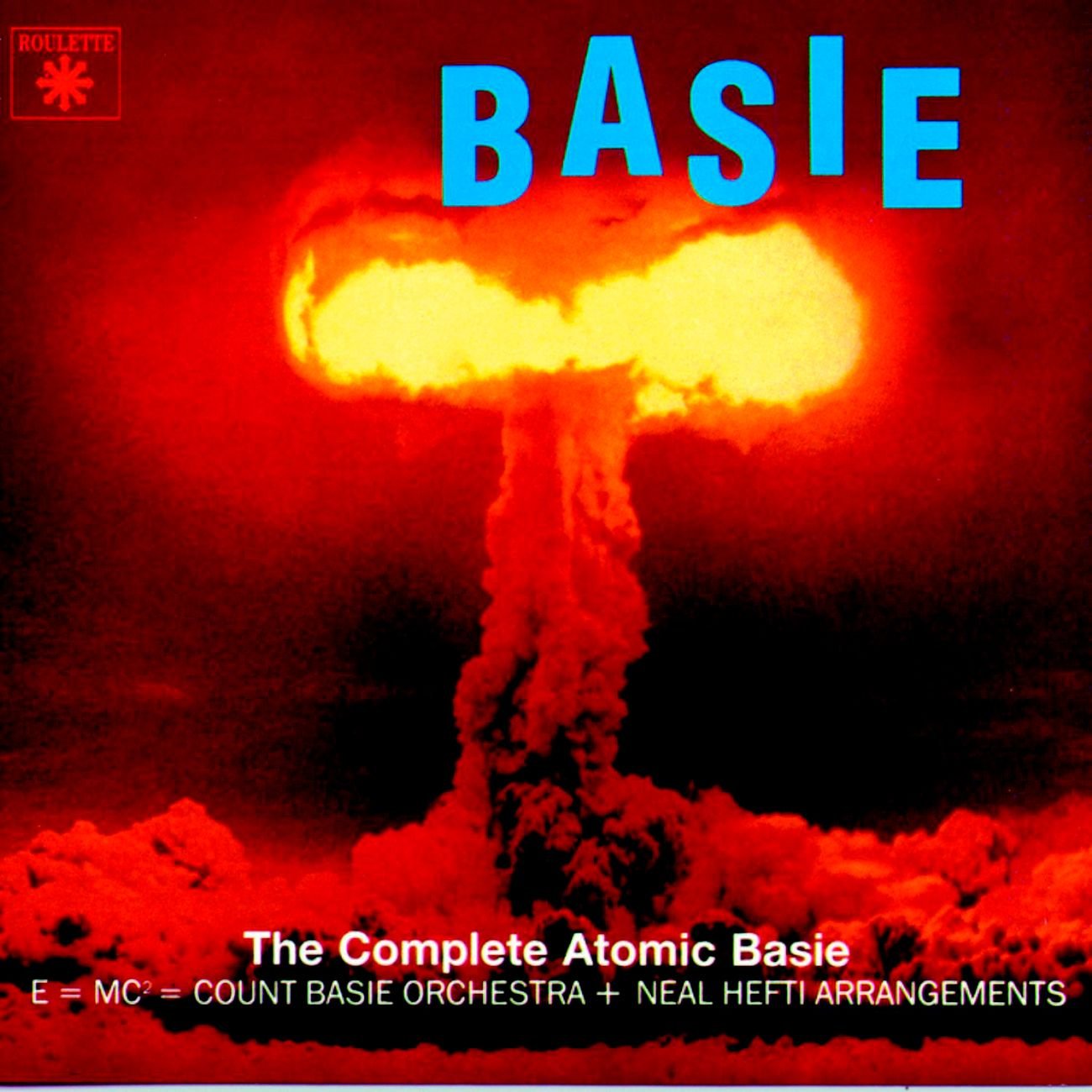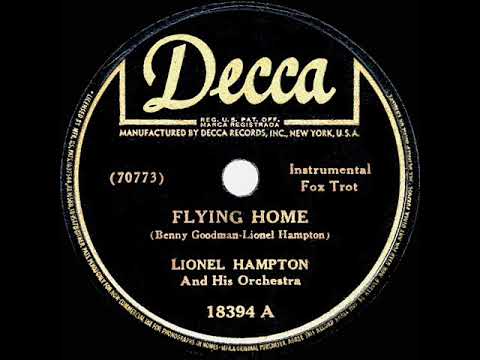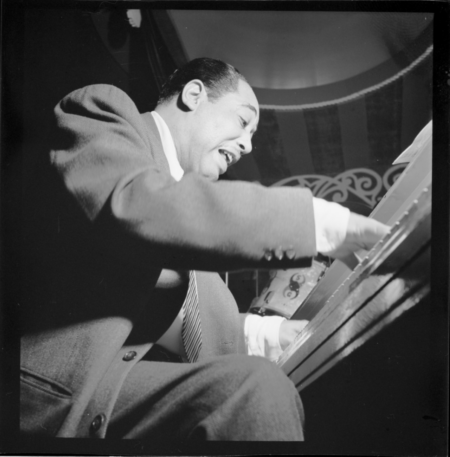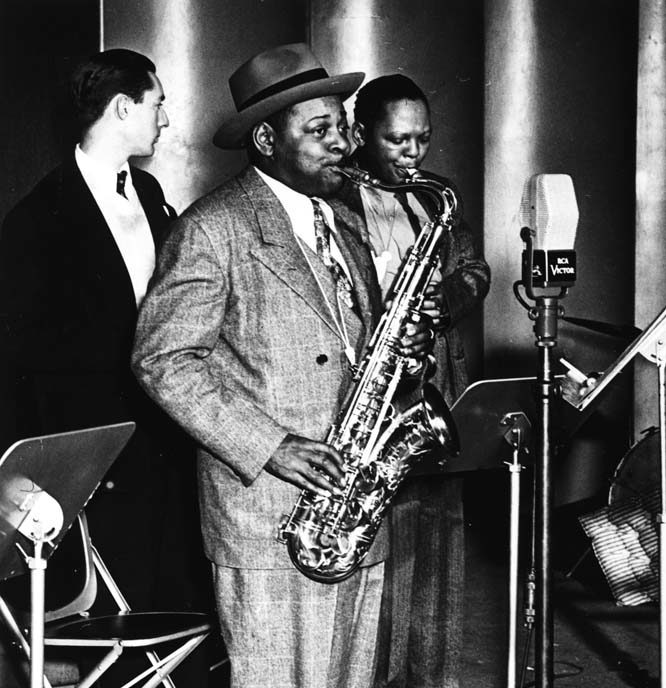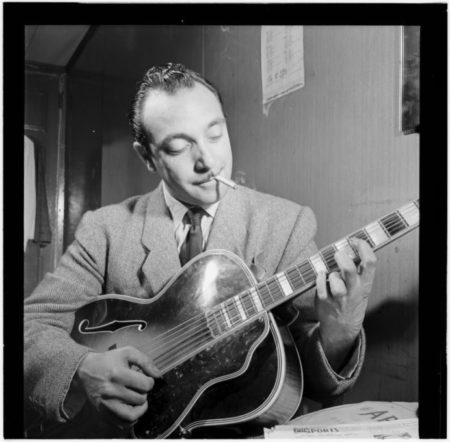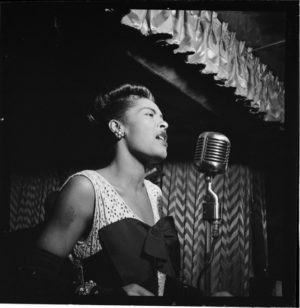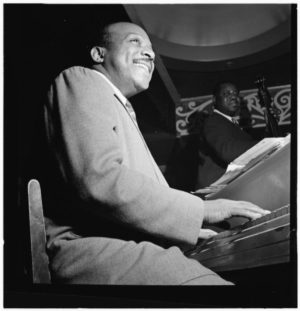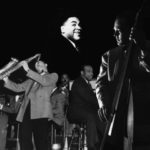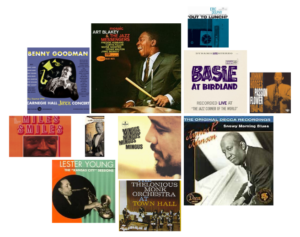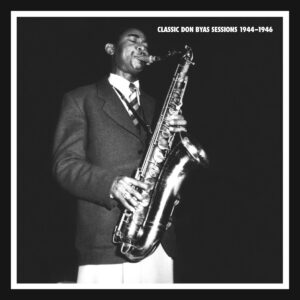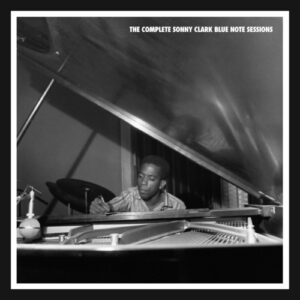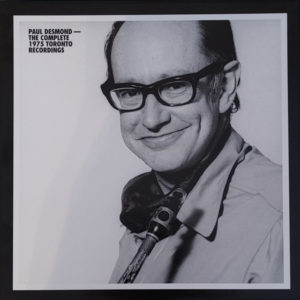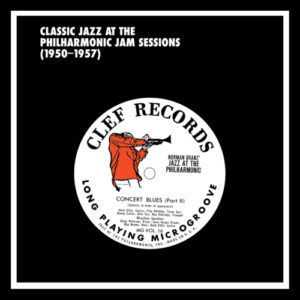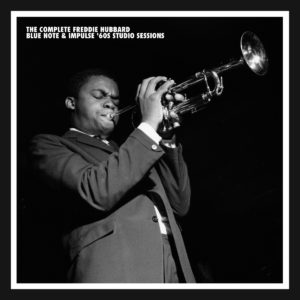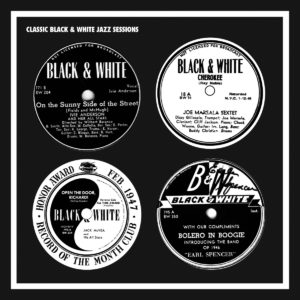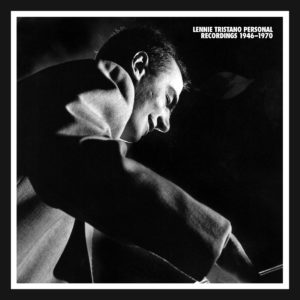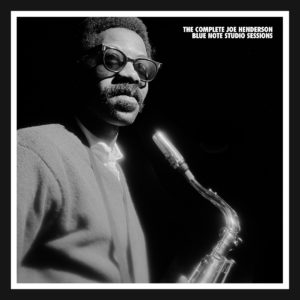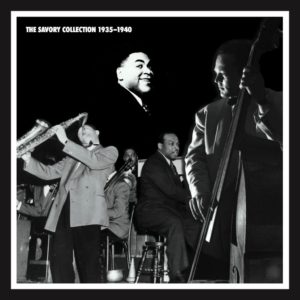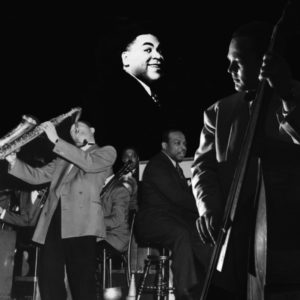Lester Young
"Lester’s style was light, and as I said, it took him maybe five choruses to warm up. But then he would really blow; then you couldn’t handle him in a cutting session." -Mary Lou Williams
Lester Young
“It was like the horn only became a transmitter through which the soul of Lester Young was expressed…When he’d still be up to play I would look around, and people would slow down so they could listen, because everybody realized then, even the people who didn’t really pay that close attention to details as far as the music was concerned, everybody seemed to sense that they were witnessing one of the greatest musicians of all time.
It was like he was a minister and we were his congregation out there. He was speaking words of wisdom to us, and very prophetic, because, his style, what he was doing then, changed the whole concept of tenor playing…it was like listening to a saxophone with the sound of a flute with that clear just mellow, rich, round sound.” – Thad Jones
By Loren Schoenberg
In the rarified precincts of the jazz pantheon, Lester Young is unique in that the true essence of his genius remains obscure. Louis Armstrong, Thelonious Monk, Art Tatum, John Coltrane and the others recorded prolifically in the studio and out of it, etching a relatively complete picture of their abilities. To be sure, there were extraordinary moments that vanished the moment they were created, lingering only in the memories of those lucky enough to have witnessed them.
But with Lester Young, the overwhelming consensus of those who heard him when he was young is that he could and frequently did play extended solos, and that it was only in that form that he could express his unique and large range of musical architecture. So we are left to parse, ever so minutely, the shards of that vision as they are to be found on the studio recordings.
“All jazz soloists up through the advent of long-playing records in the ‘50s had to learn to express themselves succinctly and no one did it any better than Lester Young at his best.”
Lester Young Joins Count Basie
When Count Basie landed an engagement at Sam Baker’s hotel in Little Rock, Arkansas early in 1934, Herschel Evans switched places with Lester Young so he could stay in Kansas City. And it was during that engagement that Lester Young received the legendary offer from Henderson to take Hawkins’ chair.
Lester Young played an active role in this. He gave a friend, George Dixon, from Earl Hines’s New York bound band, a letter for Henderson, stating his willingness to come to New York immediately if needed. Young’s replacement in Little Rock was Buddy Tate, who was to inherit Evans’ spot in the later Basie band. Most significantly, it was during this period that Lester Young began playing with Count Basie, Walter Page and Jo Jones.
The result of all those nights and the millions of quarter notes that passed between them would bear fruit when they finally recorded together on the legendary Jones-Smith recordings of November 1936.
The Legendary Lester Young & Count Basie Session
November 9, 1936
Lester Young’s first recordings took place when he was 27 years old, with a long and varied career already behind him. The great majority of his peers began recording in their early twenties and some in their teens, which makes tracing their stylistic evolution much easier:
Louis Armstrong with King Oliver
Coleman Hawkins with Fletcher Henderson
Count Basie with Bennie Moten
Teddy Wilson with Louis Armstrong
What for us is the very beginning of his oeuvre are at the same time several steps into his own mature evolution. To fully appreciate the specifics of Lester Young’s contribution to this now classic recording session, we must set it within the larger context of the entire quintet, hence the following broad analysis.
The first thing to keep in mind as you listen to the selection is that nothing like them had ever been heard before. The rhythm section communicated in a unified fashion and presented a synergistic beat that is without precedent. And in the young Lester Young there can be heard the reinvention of the tenor saxophone as well the first recorded examples of a new vocabulary for jazz.
Count Basie was a master of stride piano, which demanded equal command of the left and right hands and the ability to summon from the piano the same propelling beat associated with larger ensembles. It was during his years with the Bennie Moten band that Basie first glimpsed the possibility of a spare approach to the instrument.
Moten himself was an accomplished pianist and the two venues, with just one piano, Moten would play the bass part, leaving the treble to Basie. Some of his fellow band mates later identified this as the beginning of the famously sparse Basie style, which came to fruition with his own band a few years later.
Shoe Shine Boy
Carl “Tatti” Smith (tp), Lester Young (ts), Count Basie (p), Walter Page (b), Jo Jones (d)
Count Basie starts the issued version of Shoe Shine Boy with a brilliant opening gambit that contains more than a dollop of rhythmic, harmonic and formal ambiguity. The idiom is distinctly Walleresque. What seems to be a statement of the melody turns out to be a 16-bar introduction and, as Walter Page (with walking bass lines) and then Jo Jones (with shimmering hi-hat work) settle in, Basie gradually jettisons the striding left hand figures for a far leaner accompaniment. Here is the genesis of the contemporary jazz piano style.
Over the years, Basie’s tinkling style eclipsed the strongly linear and melodic playing heard here. Jo Jones frequently talked about this rhythm section’s penchant for rehearsing, and there are many subtle touches throughout these recordings that provide the sort of convergences of phrase that only happen in truly unified ensembles. The sprung rhythms in Basie’s left hand during the bridge lead to the descending whole-tone run that later became a trademark of one his greatest disciples, Thelonious Monk.
This is immediately followed by the very first recorded Lester Young solo (if this was indeed the first of the two versions made that day), one of his most tightly constructed compositions. Building around a three-note cell of E-Eb-D (all notes referred to are in Bb tenor saxophone key), Young unleashes two 32-bar choruses of untrammeled cohesion.
He telegraphs a feeling of restraint and rhythmic repose, but places himself squarely on top of the beat. Lester Young uses repetition to good advantage to air out his more complex phrases, and there are echoes of his early days as a drummer, especially in the second eight bars of his second chorus.
“Lester… had this remarkable ability to transmit beauty from within him to the rhythm section… He would play some lines that were so relaxed that, even at a swift tempo, the rhythm section would relax.”. – Oscar Peterson
A subtle touch is the way the rhythm section catches his accents during his bridges, all of which revolve around anticipated beats. The first one finds Jones landing flatly on the downbeat, and on the beat accent he repeats two measures later, which misses Young’s phrase by an eighth note. Jones then catches up, and on the second bridge, he waits for Lester Young to signal the accents. Basie is also a co-conspirator in this rhythmic intrigue.
As Carl Smith starts his trumpet solo, Basie switches to a totally different background. All this provides a clear picture of Walter Page’s concept of a rhythm section creating contrast to keep a performance interesting. Not content to maintain one pattern throughout an entire performance, Page taught Basie and Jones to think orchestrally and in terms of counterpoint.
Lester Young also weighs in with a never-ending set of riff variations, creating a tapestry not unlike the New Orleans jazz he had grown up with during the previous decade. Smith proves to be an exemplary player who responds to everything going on around him. The next episode finds Smith, Lester Young and Basie seamlessly trading two-bar phrases for sixteen measures. Jones, echoing his original entrance, lays out for the first eight, and with that small gesture creates a symmetry that presages the end of the performance.
His eight-bar solo is played exclusively on the snare drum. He plays the whole session on snare and hi-hat only — anticipating by several decades Leon Parker’s minimalist experiments of the 1990s. The band jams out in true New Orleans fashion, before a short reprise of the trading and the coda.
Explore More Music
Lester Young Biography
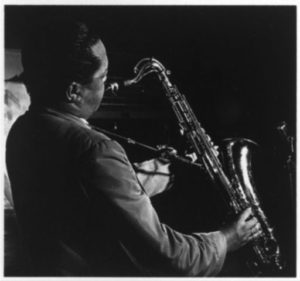
Lester Young came from a musical family led by the patriarch, William “Billy” Young, who played all the instruments and made a living first as a teacher and then as a touring bandleader. Although born at his mother’s family home in Woodville, Mississippi on August 27, 1909, Lester Young was raised in and around New Orleans, and was entranced by music from an early age.
Rhythm was vital to his music and it comes as no surprise that he started on the drums before switching to the saxophone. After the trials and tribulations that came from a sensitive nature married to an indefatigable need to assert his musical prowess, the teenaged Lester Young emerged as a demon on the soprano, alto, and baritone saxophones.
One misconception is that contrary to the legend, Lester Young was never really a Kansas City jazz musician. It’s true that he was playing there with Count Basie in 1936 when they got the call to come to New York, but he had spent the great majority of his time in the preceding years based in Minneapolis. Billy Young had established the family there in the late ‘20s and Lester found the atmosphere convivial enough to make it his home base.
It was in and around Kansas City that the best big bands in the region were located, so Lester Young began to gravitate there more and more frequently. There were stints with the famed Blue Devils, during and after Walter Page’s tenure as leader, and six months with King Oliver in 1933.
Indeed, this collaboration between Lester Young and Louis Armstrong’s mentor facilitates many fascinating connections in the jazz lineage. Many musicians have shared the bandstand for a night or two in bands put together for special occasions, but to play in a band for an extended period led by a major player cannot help but be a significant influence.
The enormity of the linkage becomes apparent when you consider that Lester shared musical ideas with both King Oliver, who was Armstrong’s mentor, and with drummer Roy Haynes, a favorite of Charlie Parker, John Coltrane and Chick Corea.
– Loren Schoenberg; liner note excerpt from Mosaic Records: The Lester Young Count Basie Sessions 1936-1940 and Classic Columbia, OKeh and Vocalion Lester Young Lester Young with Count Basie 1936-1940
Sonny Rollins Speaks of His Admiration of Lester Young
Lester Young
Selected Jazz Albums
By Scott Yanow
Musically and personally, Lester Young (1909-59) stood apart from the crowd. Back in the 1930s, during an era when nearly all tenor players sounded like a relative of Coleman Hawkins who with his large sound and harmonically complex style made the tenor-sax into a major instrument, Young emerged with a light tone and a subtle floating style that swung just as hard but at a quieter volume.
Classic Columbia, OKeh, and Vocalion Lester Young with Count Basie 1936-1940
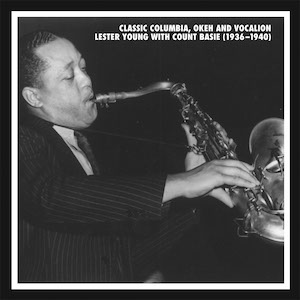
By Alan Goodman
Young briefly worked with Basie in 1934 before moving to New York to replace Hawkins in the Henderson band. His fellow band members tormented Young through some tough months, which were eased a bit by his new friendship with Billie Holiday and the beginning of their musical relationship. Unable to take the abuse on the bandstand, Young left and began drifting again in bands between Kansas City and Minneapolis. Then, one night, he heard Basie on the radio. Young went to the telegraph office to send a message to his old boss, asking for his job back.
You hear it on this collection from the opening notes of “Shoe Shine Boy,” the tune that contains Lester Young’s first recorded solo. While schooled in the stride style, Basie largely eschews what would typically be played by the left hand in favor of something sparser, while running tip-toe through the keys with his right. He could concentrate on higher, lighter tones because of the support Walter Page provides, fleetly walking through the bass strings.
Jo Jones also concentrates on the top tones, putting rhythm into the cymbals that beforehand had been played on the bass drum. Add to all this lightness the solos of Lester Young, who plays in stark contrast to the commanding honk of a Hawkins and who seems always at ease, even when working his way through the hardest driving tunes.
Basie, who always seems to be measuring out his notes with witty reserve, gives Young license and context for his own coy inventions. He could blow chorus after chorus (producer John Hammond recounted a jam session when Young played 83 straight), and his solos will disappoint a listener’s efforts to find cliches.
Just as a figure sounds familiar, he’ll hang from a note until the moment he decides to casually release his fingertips. He’ll add a little swivel to the middle of a run, like a dancer who suddenly finds her hips swinging – a delightful, private reverie. He’ll saw off a succession of notes and tie them with a string, just as an after-thought. Everything he plays is unimaginable, until he plays it. And he’ll do it endlessly, while still appearing to be holding something in reserve.
Young was fully capable of achieving a section sound on ensemble pieces, but as a soloist he chose to stand apart from his fellow musicians. It was a stance that helped make him hard to cut. His solos introduced concepts that were revolutionary for their melodic content, their rhythmic complexities, and the very way he articulated the notes, often creating sounds no one had heard before.
Classic Recordings And New Discoveries
Our 4-CD set includes 84 tracks, beginning with Basie’s and Young’s first session together under the the name “Jones-Smith Inc.” The collection is notable as well for including along with all previously-known gems on the Columbia labels, the results of our research in the vaults: almost a dozen of alternate tracks never heard before. Also included is the legendary session from the Benny Goodman Septet with Count Basie.
Sidemen in addition to Page and Jones include Buck Clayton, Charlie Christian, Freddie Green, Jimmy Rushing, Harry Edison, Vic Dickenson, and Tab Smith.
You’ll hear many tunes from the Basie book now considered classics, such as “Oh, Lady Be Good “Lonesome Miss Pretty,” “Dickie’s Dream,” Young’s signature tune “Lester Leaps In,” “Easy Does It,” and more. These are the definitive versions and the very tunes emulated by generations of saxophonists who followed Lester Young’s lead.
For the purposes of this discography, only the first issue number of each matrix is listed. All are American releases unless noted (Sd) for Sweden. To the best of our knowledge, the discography is in the order in which the tunes were recorded. However, the CDs contained in this box set are presented with the master take first and then any alternates at the conclusion of the disc.
The following arrangers are abbreviated for this set: Count Basie (CB), Buck Clayton (BC), Andy Gibson (AG), Elton Hill (EH), Skippy Martin (SM), Jimmy Mundy (JM), Don Redman (DR), Tab Smith (TS), Henri Woode (HW).
________________________________________________________________________
(A) JONES-SMITH INC
Carl “Tatti” Smith (tp), Lester Young (ts), Count Basie (p), Walter Page (b), Jo Jones (d), Jimmy Rushing (vcl).
Chicago, November 9, 1936
C 1657-2 Shoe Shine Boy Tax (Sd) m-8000 (LP)
C 1657-1 Shoe Shine Boy Voc 3441
C 1658-1 Evenin’ (JR-vcl) –
C 1659-1 Boogie Woogie (JR-vcl) Voc 3459
C 1660-1 Oh, Lady Be Good –
Note: Although the Vocalion ledgers and cards state the session above took place on October 9, 1936, this seems to be a clerical error. All accounts from the musicians, John Hammond and adjacent matrix numbers, confirm that November 9th is the correct date.
The initial artist credit listed in the ledgers for this session was “Jones-Smith Inc. of Kansas City”.
________________________________________________________________________
(B) BASIE’S BAD BOYS
Buck Clayton, Shad Collins (tp), Dan Minor (tb) -1, Lester Young (cl, ts), Count Basie (p, org), Freddie Green (g), Walter Page (b), Jo Jones (d), Jimmy Rushing (vcl).
Chicago, February 13, 1939
24510-1 I Ain’t Got Nobody Col G 31224 (LP)
24511-1 Goin’ To Chicago (JR-vcl) -1 –
24512-1 Live And Love Tonight –
24513-1 Love Me Or Leave Me –
Note: The CD reissuecount basie – america’s #1 band incorrectly lists this session as being first issued on CBS 66101 as a 10″ LP in 1952. CBS 66101 is actually a set of 10 LPs.
Some discographies list Dicky Wells as the trombonist on Goin’ To Chicago. However, the Vocalion ledgers show his name was erased (but still somewhat visable) and Dan Minor’s name penciled in. ________________________________________________________________________
(C) COUNT BASIE AND HIS ORCHESTRA: Buck Clayton, Shad Collins, Harry Edison, Ed Lewis (tp), Dan Minor, Benny Morton, Dicky Wells (tb), Earle Warren (as), Buddy Tate, Lester Young (ts), Jack Washington (as, bari), Count Basie (p), Freddie Green (g), Walter Page (b), Jo Jones (d), Helen Humes, Jimmy Rushing (vcl).
NYC, March 19, 1939
W24238-2 What Goes Up Must Come Down (JR-vcl) Col JG 34840 (LP)
W24238-1 What Goes Up Must Come Down (JR-vcl) Voc 4734
W24242-2 Taxi War Dance Col JG 34840 (LP)
W24242-1 Taxi War Dance Voc 4748
________________________________________________________________________
(D) COUNT BASIE AND HIS ORCHESTRA: Same as (C).
NYC, March 20, 1939
W24243-2 Don’t Worry ‘Bout Me (HH-vcl) (AG-arr) Col JG 34840 (LP)
W24243-1 Don’t Worry ‘Bout Me (HH-vcl) (AG-arr) Voc 4734
________________________________________________________________________
(E) COUNT BASIE AND HIS ORCHESTRA: Same as (C).
NYC, April 5, 1939
W24337-A And The Angels Sing (HH-vcl) Voc 4784
W24338-A If I Didn’t Care (HH-vcl) –
W24339-A Twelfth Street Rag Voc 4886
W24340-A Miss Thing (Pt.1) (SM-arr) Voc 4860
W24341-A Miss Thing (Pt.2) (SM-arr) –
Note: The Vocalion ledgers state that miss thing (both parts) were “to be rerecorded – con’t 4-17-39”. The metal parts also show the April 5th date as being crossed out and 4/17/39 entered instead. However, the Basie band was at the Royal Theater in Baltimore during April 14th through the 20th. Some discographies list Jimmy Mundy as the arranger for miss thing.
________________________________________________________________________
(F) COUNT BASIE AND HIS ORCHESTRA: Same as (C).
Chicago, May 19, 1939
WC 2594-A Lonesome Miss Pretty (BC-arr) Col CL 6079 (LP)
WC 2595-A Bolero At The Savoy (HH-vcl) (JM-arr) Tax (Sd) m-8000 (LP)
WC 2597-A Pound Cake (CB-arr) Voc 5085
Note: Each of the titles from this session were initially issued (and frequently re-issued) using the “C” takes, which are dubs of the “A” takes. For this set we used the “A” takes. ________________________________________________________________________
(G) COUNT BASIE AND HIS ORCHESTRA: Same as (C).
Chicago, June 24, 1939
WC 2632-B You Can Count On Me (HH-vcl) Col JG 34840 (LP)
WC 2632-A You Can Count On Me (HH-vcl) Voc 4967
________________________________________________________________________
(H) GLENN HARDMAN AND HIS HAMMOND FIVE: Lee Castle (tp), Lester Young (cl, ts), Glenn Hardman (org), Freddie Green (g), Jo Jones (d).
Chicago, June 26, 1939
WC 2636-A China Boy Col 35341
WC 2637-B Exactly Like You Col JG 34840 (LP)
WC 2637-A Exactly Like You Voc 4971
WC 2638-A On The Sunny Side Of The Street Col 35341
WC 2639-A Upright Organ Blues Col 35263
WC 2640-A Who ? Voc 4971
WC 2641-A Jazz Me Blues Col 35263
Note: This session can be found on Disc IV of this set.
________________________________________________________________________
(I) COUNT BASIE AND HIS ORCHESTRA: Same as (C).
NYC, August 4, 1939
W 24979-A Song Of The Islands (poss. BC-arr) Voc 5169
W 24981-A Clap Hands, Here Comes Charlie (SM-arr) Voc 5085
________________________________________________________________________
(J) COUNT BASIE KANSAS CITY SEVEN: Buck Clayton (tp), Dicky Wells (tb), Lester Young (ts), Count Basie (p), Freddie Green (g), Walter Page (b), Jo Jones (d).
NYC, September 5, 1939
W 25296-3 Dickie’s Dream Tax (Sd) m-8000 (LP)
W 25296-2 (BD) Dickie’s Dream –
W 25296-1 Dickie’s Dream Voc 5118
W 25297-2 Lester Leaps In Col D-77 (LP)
W 25297-1 Lester Leaps In Voc 5118
Note: The original title of Dickie’s Dream, according to the Vocalion ledgers, was to be conversation piece. Some LP issues list -4 for Dickie’s Dream, however, this is not a different take but a copy of the master take (-1). Some discographies also list -4 as the 78 master take.
________________________________________________________________________
(K) COUNT BASIE AND HIS ORCHESTRA: Same as (C).
L.A., November 6, 1939
WCO 26276-A (-2) The Apple Jump (AG-arr) OK 5862
(WCO 26277) -2 I Left My Baby (JR-vcl) (AG-arr) previously unissued
(WCO 26277) -6 (BD) I Left My Baby (JR-vcl) (AG-arr) –
WCO 26277-A (-7) I Left My Baby (JR-vcl) (AG-arr) Col 35321
(WCO 26278) -1 Riff Interlude (CB-arr) previously unissued
(WCO 26278) -2 Riff Interlude (CB-arr) –
(WCO 26278) -3 (BD) Riff Interlude (CB-arr) –
(WCO 26278) -4 Riff Interlude (CB-arr) –
WCO 26278-A (-5) Riff Interlude (CB-arr) Col 35321
Note: This session and the next were transferred from newly found lacquer discs which bear the prefix HH in addition to an individual disc number (HH 2406, HH 2407, etc.). No mention is made of the regular WCO matrix number on these lacquers and each individual take is listed numerically rather than alphabetically as is found on the issued 78.
The first attempts (-1) of the Apple Jump and I Left My Baby are both short breakdowns and are not included here. The sixth take of I Left My Baby is another breakdown and can be heard right after the alternate take -2 at the end of Disc II. The lacquer disc or discs that have takes -3, -4 and -5 of I Left My Baby are no longer in the physical possession of Sony and are feared lost or were destroyed.
The ledgers claim that this and the next session were “to be rerecorded – 11-20-39″ and even some of the dates on the metal parts (stating 11/7) are crossed out as well. However, November 7th is the correct date as the Basie band were traveling on one-nighters at this time and on the 20th were in Monroe, La.
Epic LN 3168 (LP), Let’s Go To Prez, states that an unreleased take was used for riff interlude. However, -A is the take that is used.
________________________________________________________________________
(L) COUNT BASIE AND HIS ORCHESTRA: Same as (C).
L.A., November 7, 1939
(WCO 26280) -1 (BD) Between The Devil And The
Deep Blue Sea (HH-vcl) (AG-arr) previously unissued
(WCO 26280) -2 (BD) Between The Devil
And The Deep Blue Sea (AG-arr) –
(WCO 26280) -3 Between The Devil And The
Deep Blue Sea (HH-vcl) (AG-arr) –
WCO 26280-A (-4) Between The Devil And The
Deep Blue Sea (HH-vcl) (AG-arr) Col 35357
(WCO 26280) -5 Between The Devil And The
Deep Blue Sea (HH-vcl) (AG-arr) previously unissued
(WCO 26281) -5 (BD) Ham ‘N’ Eggs (CB-arr) –
(WCO 26281) -6 Ham ‘N’ Eggs (CB-arr) –
WCO 26281-A (-7) Ham ‘N’ Eggs (CB-arr) Col 35357
(WCO 26282) -1 Hollywood Jump (AG-arr) previously unissued
WCO 26282-A (-2) Hollywood Jump (AG-arr) Col 35338
Note: See above for details on the matrix system for this session. The two breakdowns on Between The Devil and The Deep Blue Sea can be heard together on track 11 of Disc III.
The disc or discs that have takes -1 through -4 of Ham ‘n’ Eggs are no longer in the physical possession of Sony and are feared lost or were destroyed. Epic LN 3168 (LP), Let’s Go To Prez, states that an unreleased take was used for Ham ‘n’ Eggs. However, -A (-2) is the take that is used.
________________________________________________________________________
(M) COUNT BASIE AND HIS ORCHESTRA: Buck Clayton, Harry Edison, Al Killian, Ed Lewis (tp), Vic Dickenson, Dan Minor, Dicky Wells (tb), Earle Warren (as), Buddy Tate, Lester Young (ts), Jack Washington (as, bari), Count Basie (p), Freddie Green (g), Walter Page (b), Jo Jones (d), Helen Humes, Jimmy Rushing (vcl).
NYC, March 19, 1940
WCO 26655-A I Never Knew (AG-arr) Col 35521
WCO 26656-A Tickle-Toe (AG-arr) –
WCO 26657-B Let’s Make Hay While
The Moon Shines (EH-arr) Col G 31224 (LP)
WCO 26657-A Let’s Make Hay While
The Moon Shines (EH-arr) Col 35500
WCO 26658-B Louisiana (AG-arr) Epic LN 3168 (LP)
WCO 26658-A Louisiana (AG-arr) Col 35448
Note: Epic LN 3168 (LP), Let’s Go To Prez, states that an unreleased take was used for Tickle Toe. However, -A is the take that is used. The same Epic LP does not list louisiana as an unreleased alternate. Some discographies claim Tadd Dameron as the arranger on Louisiana.
________________________________________________________________________
(N) COUNT BASIE AND HIS ORCHESTRA: Same as (M).
NYC, March 20, 1940
CO 26659-A Easy Does It (JM-arr) Col 35448
CO 26660-B Let Me See (AG-arr) Col C2 34849 (LP)
CO 26660-A Let Me See (AG-arr) OK 6330
Note: According to the metal part, easy does it was originally titled music easy.
________________________________________________________________________
(O) COUNT BASIE AND HIS ORCHESTRA: Same as (M) except add Tab Smith (as, arr).
NYC, May 31, 1940
W 26870-B Blow Top (TS-arr) OK 5629
W 26870-A Blow Top (TS-arr) Epic LN 3168 (LP)
Note: Epic LN 3168 (LP), let’s go to prez, does not list blow top as an unreleased alternate.
________________________________________________________________________
(P) COUNT BASIE AND HIS ORCHESTRA: Same as (M).
Chicago, August 8, 1940
WC 3254-A Evenin’ (JR-vcl) OK 5732
WC 3255-A The World Is Mad (Pt.1) (AG-arr) OK 5816
WC 3256-A The World Is Mad (Pt.2) (AG-arr) –
________________________________________________________________________
(Q) BENNY GOODMAN SEPTET: Buck Clayton (tp), Lester Young (ts), Benny Goodman (cl), Count Basie (p), Charlie Christian (el-g), Freddie Green (g), Walter Page (b), Jo Jones (d).
NYC, October 28, 1940
-0- Ad Lib Blues Jazz Archives 6 (LP)
-0- Wholly Cats –
-0- Charlie’s Dream –
-0- I Never Knew –
-0- Lester’s Dream –
________________________________________________________________________
(R) COUNT BASIE AND HIS ORCHESTRA: Same as (M).
NYC, October 30, 1940
CO 29008-3 What’s Your Number? (BC-arr) Col C2 34849 (LP)
CO 29008-2 What’s Your Number? (BC-arr) Tax (Sd) m-8027 (LP)
CO 29008-1 What’s Your Number? (BC-arr) OK 5897
Note: According to the OKeh ledgers this was originally titled Swing Low, Sweet Rhythm.
Columbia C2 34849 (LP) incorrectly lists -2 as -3 and -3 as -2.
________________________________________________________________________
(S) COUNT BASIE AND HIS ORCHESTRA: Same as (M).
NYC, November 19, 1940
CO 29087-2 Five O’Clock Whistle (DR-arr) Col C2 34849 (LP)
CO 29087-BD Five O’Clock Whistle (DR-arr) –
CO 29087-1 Five O’Clock Whistle (DR-arr) OK 5922
CO 29090-2 Broadway (HW-arr) Col C2 34849 (LP)
CO 29090-1 Broadway (HW-arr) OK 6095
Note: Some discographies and LP reissues (including Columbia C2 34849) incorrectly list the master take of Five O’Clock Whistle as -3 on OKeh 5922 and the alternate as -1. Columbia C2 34849 also lists -2 as -1.
________________________________________________________________________
ALBUM INDEX:
10″ LPs:
Columbia CL 6079 Count Basie – Count Basie Dance Parade
12” LPs:
Columbia Record Club D-77 Various Artists – The Sound Of Jazz Genius
Columbia G 31224 Count Basie – Super Chief
Columbia JG 34840 The Lester Young Story, Vol.3 – Enter The Count
Columbia C2 34849 The Lester Young Story, Vol.5 – Evening Of A
Basie-ite
Epic LN 3168 Lester Young / Count Basie – Let’s Go To Prez
Jazz Archives 6 Charlie Christian & Lester Young – Together 1940
Tax (Sweden) m-8000 Lester Young – The Alternative Lester
Tax (Sweden) m-8027 Count Basie – The Jitters
Original sessions supervised by: John Hammond
Produced for release by: Scott Wenzel
Executive Producer: Michael Cuscuna
Disc transfers: Michael Brooks, Matt Cavaluzzo, Andreas Meyer, Mark Wilder
Mastered using 24-bit technology by Malcolm Addey
Vault research: Michael Brooks, Anthony Fountain, Scott Wenzel
Special thanks: Michael Brooks, Tom Doerr, The Institute of Jazz Studies, Robin Manning, Dan Morgenstern, Michael Panico, Phil Schaap and Tom Tierney.
The master take of What Goes Up Must Come Down provided by Scott Wenzel. The remainder of the sources came from either metal parts or lacquer discs. The unissued material came from lacquers that were recently located by Michael Brooks at Sony Studios.
This compilation (p) 2008 SONY BMG MUSIC ENTERTAINMENT /Manufactured by SONY BMG MUSIC ENTERTAINMENT, 550 Madison Avenue, New York, NY 10022-3211/WARNING All Rights Reserved. Unauthorized duplication is a violation of applicable laws.
© 2008 Mosaic Records L.L.C., 35 Melrose Place, Stamford, CT 06902. All rights reserved.
Phone: 203-327-7111/Fax 203-323-3526/ Website: www.mosaicrecords.com.
PRODUCER’S NOTE:
The focus of this set was to present all of Lester Young’s solo efforts under Count Basie’s leadership for the Columbia family of labels. In addition, we have included the Glenn Hardman and his Hammond Five date plus a Benny Goodman small group session that went unreleased until 1973.
In addition to the original file cards and ledgers, the following sources were used for this discography: Lestorian Notes – A Discography & Biography of Lester Young by Piet Koster and Harm Moback (Micrography Pub.), The Jazz Discography by Tom Lord (Cadence Jazz Books), Jazz Records 1897-1942 Sixth Edition by Brian Rust (Storyville) and Count Basie: A Bio-Discography by Chris Sheridan (Greenwood Press).
Scott Wenzel
Classic 1936-1947 Count Basie And Lester Young Studio Sessions
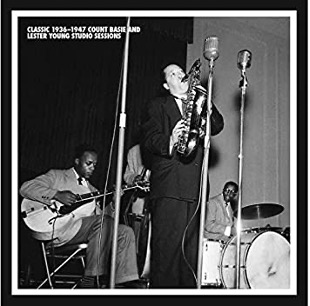
Together “Pres” & Basie Began To Completely Reinvent Jazz
It was an era when the music was in transition; a time when musicians were achieving new milestones of personal expression; a point in his career when Basie, with Young and others beside him, was establishing his credentials as one of the leading band leaders of the swing era; and the moment when Lester Young was creating a completely new approach to the tenor saxophone. Without reservation, we can assure you these are masterpieces.
The suppleness of the Basie, Jones and Page rhythm section and how conducive it was for electrifying soloists has been well-documented. But you can’t overstate the effect on Lester Young. Other musicians – great ones – would build solos that seemed utterly brilliant for their organization and improvised cleverness. Young’s seemed brilliant for arriving places utterly unexpected. For decades, saxophonists have sought to match his level of carefree, confident command.
Our 4 CD set includes 84 tracks, beginning with Basie’s and Young’s first session together under the the name “Jones-Smith Inc.” The collection is notable as well for including along with all previously-known gems on the Columbia labels, the results of our research in the vaults: almost a dozen of alternate tracks never heard before. Also included is the legendary session from the Benny Goodman Septet with Count Basie. Sidemen in addition to Page and Jones include Buck Clayton, Charlie Christian, Freddie Green, Jimmy Rushing, Harry Edison, Vic Dickenson, and Tab Smith.
You’ll hear many tunes from the Basie book now considered classics, such as “Oh, Lady Be Good “Lonesome Miss Pretty,” “Dickie’s Dream,” Young’s signature tune “Lester Leaps In,” “Easy Does It,” and more. These are the definitive versions and the very tunes emulated by generations of saxophonists who followed Lester Young’s lead.
For the purposes of this discography, only the first release of each matrix is listed. All titles in this discography were released initially on 78 except where noted. Non-U.S. releases are abbreviated (Aus) for Australia, (F) for France (It) for Italy and (Sd) for Sweden. Abbreviations to the matrix numbers include BD for breakdown and INC for incomplete.
To the best of our knowledge, this discography is presented in the order in which each take was recorded. However, the CDs contained in this set are sequenced with the master take first and then any alternates at the conclusion of the disc. Any sides that have been shown in discographies but are missing from the vaults or possibly in private collections are listed as unissued, master no longer exists.
The following reference materials used for this discography were The Aladdin/Imperial Labels: A Discography by Michel Ruppli (Greenwood Press), Both Sides Now Publications: Philo/Aladdin Singles Discography (www.bsnpubs.com/index.html), The Complete Commodore Jazz Recordings: A Discography by Vincent Pelote and the three discographies that accompanied our Mosaic-Commodore LP sets compiled by Michael Cuscuna (via research from Milt Gabler’s original session notes), Count Basie: A Bio-Discography by Chris Sheridan (Greenwood Press) and The Jazz Discography by Tom Lord (Cadence Jazz Books).
Label Abbreviations: Alad for Aladdin, BB for Bluebird, Br for Brunswick, Dec for Decca, Com for Commodore, EmA for EmArcy, JS for Jazz Selection, Key for Keynote, Merc for Mercury, QD for Queen Disc, Sig for Signature, Vic for Victor and Voc for Vocalion.
________________________________________________________________________
(A) JONES-SMITH INC: Carl “Tatti” Smith (tp), Lester Young (ts), Count Basie (p), Walter Page (b), Jo Jones (d), Jimmy Rushing (vcl).
Chicago, November 9, 1936
Supervised by John Hammond
C 1657-2 Shoe Shine Boy Tax (Sd) m-8000 (LP)
C 1657-1 Shoe Shine Boy Voc 3441
C 1658-2 Evenin’ (JR-vcl) previously unissued
C 1658-1 Evenin’ (JR-vcl) Voc 3441
C 1659-2 Boogie Woogie (JR-vcl) previously unissued
C 1659-1 Boogie Woogie (JR-vcl) Voc 3459
C 1660-2 Oh, Lady Be Good previously unissued
C 1660-1 Oh, Lady Be Good Voc 3459
Note: Although the Vocalion ledgers and cards state the session above took place on October 9, 1936, this seems to be a clerical error. All accounts from the musicians, John Hammond and adjacent matrix numbers, confirm that November 9th is the correct date.
The initial artist credit listed in the ledgers for this session was “Jones-Smith Inc. of Kansas City”.
________________________________________________________________________
(B) COUNT BASIE AND HIS ORCHESTRA: Joe Keyes, Buck Clayton, Carl Smith (tp), George Hunt, Dan Minor (tb), Caughey Roberts, Jack Washington (as), Lester Young, Herschel Evans (ts), Count Basie (p, arr), Claude Williams (g), Walter Page (b), Jo Jones (d), Jimmy Rushing (vcl), Fletcher Henderson, Don Redman, Buster Smith (arr).
NYC, January 21, 1937
61542-B Honeysuckle Rose (FH-arr) previously unissued
61542-A Honeysuckle Rose (FH-arr) Dec 1141
61543-A Pennies From Heaven (JR-vcl) (DR-arr) Dec 1121
61544-A Swinging At The Daisy Chain (BS or CB-arr) –
61545-A Roseland Shuffle (FH-arr) Dec 1141
________________________________________________________________________
(C) COUNT BASIE AND HIS ORCHESTRA: Ed Lewis, Buck Clayton, Bobby Moore (tp), George Hunt, Dan Minor (tb), Caughey Roberts (as), Lester Young, Herschel Evans (ts), Jack Washington (as, bari), Count Basie (p), Freddie Green (g), Walter Page (b), Jo Jones (d), Jimmy Rushing (vcl), Fletcher Henderson, Don Redman (arr).
NYC, March 26, 1937
62078-A Exactly Like You (JR-vcl) (poss. DR-arr) Dec 1252
62079-A Boo-Hoo (JR-vcl) (poss. FH-arr) Dec 1228
62080-A The Glory Of Love (poss. FH-arr) –
62081-A Boogie Woogie (I May Be Wrong) (head arr) (JR-vcl) Dec 1252
________________________________________________________________________
(D) TEDDY WILSON AND HIS ORCHESTRA: Buck Clayton (tp), Buster Bailey (cl), Lester Young (ts), Teddy Wilson (p), Freddie Green (g), Walter Page (b), Jo Jones (d).
NYC, June 1, 1937
Supervised by John Hammond
B-21220-3 I’ve Found A New Baby Tax (Sd) m-8000 (LP)
B-21220-1 I’ve Found A New Baby Br 7926
________________________________________________________________________ (E) COUNT BASIE AND HIS ORCHESTRA: Ed Lewis, Buck Clayton, Bobby Moore (tp), George Hunt, Dan Minor (tb), Earle Warren (as), Lester Young, Herschel Evans (ts), Jack Washington (as, bari), Count Basie (p), Freddie Green (g), Walter Page (b), Jo Jones (d), Jimmy Rushing (vcl), Eddie Durham, Skippy Martin, Buster Smith (arr).
NYC, July 7, 1937
62331-B (You Know It All) Smarty (SM-arr) Dec 1379
62332-A One O’Clock Jump (ED, BS-arr) Dec 1363
62333-A Listen My Children And
You Shall Hear (JR-vcl) (ED-arr)Dec 1379
62334-A John’s Idea (ED-arr) Dec 1363
________________________________________________________________________
(F) COUNT BASIE AND HIS ORCHESTRA: Ed Lewis, Buck Clayton, Bobby Moore (tp), George Hunt (tb), Eddie Durham (tb, el-g, arr), Dan Minor (tb), Earle Warren (as, vcl), Lester Young, Herschel Evans (ts), Jack Washington (as, bari), Count Basie (p), Freddie Green (g), Walter Page (b), Jo Jones (d), Jimmy Rushing (vcl), Skippy Martin (arr).
NYC, August 9, 1937
62511-A Good Morning Blues (JR-vcl) (ED-arr) Dec 1446
62511-B Good Morning Blues (JR-vcl) (ED-arr) –
62512-A Our Love Was Meant To Be (EW-vcl) (SM-arr) –
62513-A Time Out (ED-arr) Dec 1538
62514-A Topsy (ED-arr) Dec 1770
________________________________________________________________________
(G) COUNT BASIE AND HIS ORCHESTRA: Same as (F) except Bennie Morton (tb) replaces Hunt.
NYC, October 13, 1937
62682-A I Keep Remembering (Someone I
Should Forget) (JR-vcl) (ED-arr) Dec 1581
62683-A Out The Window (ED-arr) –
62684-A Don’t You Miss Your Baby? (JR-vcl) (ED-arr) Dec 1770
62685-A Let Me Dream (EW-vcl) (ED-arr) Dec 1538
Note: Although many recordings list Bennie Morton’s name as “Benny” we have opted for the spelling Morton preferred.
________________________________________________________________________
(H) COUNT BASIE AND HIS ORCHESTRA: Ed Lewis (tp), Buck Clayton (tp, arr), Karl George or Bobby Hicks (tp), Bennie Morton (tb), Eddie Durham (tb, el-g, arr), Dan Minor (tb), Earle Warren (as), Lester Young, Herschel Evans (ts), Jack Washington (as, bari), Count Basie (p), Freddie Green (g), Walter Page (b), Jo Jones (d), Jimmy Rushing (vcl).
NYC, January 3, 1938
63122-A Georgiana (JR-vcl) (ED-arr) Dec 1682
63123-A Blues In The Dark (JR-vcl) (BC-arr) –
Note: Buck Clayton and Bennie Morton had confirmed that trumpeter Karl George was with the band at this point, while Earle Warren claimed it was Bobby Hicks.
________________________________________________________________________
(I) COUNT BASIE AND HIS ORCHESTRA: Ed Lewis (tp), Buck Clayton (tp, arr), Harry Edison (tp), Bennie Morton (tb), Eddie Durham (tb, el-g, arr), Dan Minor (tb), Earle Warren, Jack Washington (as, bari), Lester Young, Herschel Evans (ts), Count Basie (p), Freddie Green (g), Walter Page (b), Jo Jones (d), Jimmy Rushing (vcl).
NYC, February 16, 1938
63286-A Sent For You Yesterday And Here
You Come Today (JR-vcl) (poss. ED-arr) Dec 1880
63287-A Every Tub (ED-arr) Dec 1728
63288-A Now Will You Be Good? (JR-vcl) (ED-arr) –
63289-A Swinging The Blues (ED-arr) Dec 1880
________________________________________________________________________
(J) BENNY GOODMAN AND HIS ORCHESTRA: Harry James, Ziggy Elman, Chris Griffin (tp), Red Ballard, Vernon Brown (tb), Benny Goodman (cl), Hymie Schertzer, Dave Matthews (as), Lester Young, Babe Russin (ts), Jess Stacy (p), Freddie Green (g), Walter Page (b), Lionel Hampton (d), Edgar Sampson (arr).
NYC, March 9, 1938
BS-021128-1 Ti-Pi-Tin (ES-arr) Vic 25814
Note: There is an unissued alternate take (-2) of this title, however, it is not included here because the tenor solo is by Babe Russin and not Lester Young.
________________________________________________________________________
(K) COUNT BASIE AND HIS ORCHESTRA: Ed Lewis, Buck Clayton, Harry Edison (tp), Bennie Morton (tb), Eddie Durham (tb, el-g, arr), Dan Minor (tb), Earle Warren (as), Lester Young (cl, ts), Herschel Evans (cl, ts, arr), Jack Washington (as, bari), Count Basie (p), Freddie Green (g), Walter Page (b), Jo Jones (d), Jimmy Rushing (vcl), Edgar Battle, Don Kirkpatrick (arr).
NYC, June 6, 1938
63918-A Mama Don’t Want No Peas An’
Rice An’ Cocoanut Oil (JR-vcl) (DK-arr) Dec 2030
63919-A Blue And Sentimental (ED-arr) Dec 1965
63920-A Doggin’ Around (HE, EB-arr / or ED-arr) –
________________________________________________________________________
(L) COUNT BASIE AND HIS ORCHESTRA: Ed Lewis, Buck Clayton, Harry Edison (tp), Bennie Morton, Dicky Wells, Dan Minor (tb), Earle Warren, Jack Washington (as), Lester Young (cl, ts), Herschel Evans (cl, ts, arr), Count Basie (p), Freddie Green (g), Walter Page (b), Jo Jones (d), Jimmy Rushing (vcl), Don Redman (arr).
NYC, August 22, 1938
64471-B Stop Beatin’ ‘Round
The Mulberry Bush (JR, ens.-vcl) (DR-arr) Dec 2004
64471-A Stop Beatin’ ‘Round
The Mulberry Bush (JR, ens.-vcl) (DR-arr) –
64472-A London Bridge Is Falling Down (JR-vcl) (DR-arr) –
64473-A Texas Shuffle (HE-arr) Dec 2030
64474-A Jumpin’ At The Woodside (head arr) Dec 2212
________________________________________________________________________
(M) KANSAS CITY SIX: Buck Clayton (tp), Eddie Durham (tb, el-g, arr), Lester Young (cl, ts), Freddie Green (g, vcl), Walter Page (b), Jo Jones (d).
Brunswick Studio, NYC, September 27, 1938
Supervised by Milt Gabler
P-23421-1 Way Down Yonder In New Orleans (#2) Tax (Sd) m-8000 (LP)
P-23421-2 Way Down Yonder In New Orleans Com 512
P-23422-1 Countless Blues (Ad Lib Jump Blues) Com 509
P-23422-2 Countless Blues (Ad Lib Jump Blues) (#2) Tax (Sd) m-8000 (LP)
P-23423-1 Them There Eyes (#2) (FG-vcl) –
P-23423-2 Them There Eyes (FG-vcl) Com 511
P-23424-1 I Want A Little Girl Com 509
P-23424-2 I Want A Little Girl (#2) Tax (Sd) m-8000 (LP)
P-23425-1 Pagin’ The Devil Com 512
P-23425-2 Pagin’ The Devil (#2) Tax (Sd) m-8000 (LP)
________________________________________________________________________
(N) COUNT BASIE At The Piano: Count Basie (p), Freddie Green (g), Walter Page (b), Jo Jones (d).
NYC, November 9, 1938
64731-A How Long How Long Blues Dec 2355
64731-B How Long How Long Blues unissued, master no longer exists
64732-A The Dirty Dozens Dec 2498
64733-A Hey Lawdy Mama Dec 2722
64734-A The Fives –
64735-A Boogie Woogie Dec 2355
Note: Matrix 64731-B has been rumored to exist on Decca 2355, however, a copy of this has yet to be confirmed.
________________________________________________________________________
(O) COUNT BASIE AND HIS ORCHESTRA: Ed Lewis, Shad Collins, Buck Clayton, Harry Edison (tp), Bennie Morton, Dicky Wells, Dan Minor (tb), Earle Warren (as), Lester Young, Herschel Evans (ts), Jack Washington (as, bari), Count Basie (p), Freddie Green (g), Walter Page (b), Jo Jones (d), Helen Humes, Jimmy Rushing (vcl), Andy Gibson, Jimmy Mundy, Don Redman, Buster Smith (arr).
NYC, November 16, 1938
64746-A Dark Rapture (HH-vcl) (DR or JM-arr) Dec 2212
64747-A Shorty George (AG-arr) Dec 2325
64748-A The Blues I Like To Hear (JR-vcl) (BS-arr) Dec 2284
64749-A Do You Wanna Jump Children? (JR-vcl) (AG-arr) Dec 2224
64750-A Panassie Stomp (head arr) –
________________________________________________________________________
(P) COUNT BASIE AND HIS ORCHESTRA: Ed Lewis, Shad Collins, Buck Clayton, Harry Edison (tp), Bennie Morton, Dicky Wells, Dan Minor (tb), Earle Warren, Jack Washington (as), Lester Young, Herschel Evans (ts), Count Basie (p), Freddie Green (g), Walter Page (b), Jo Jones (d), Helen Humes (vcl), Jimmy Mundy (arr).
NYC, January 5, 1939
64851-A My Heart Belongs To Daddy (HH-vcl) (JM-arr) Dec 2249
64852-A Sing For Your Supper (HH-vcl) (JM-arr) –
Note: As “Helen Hume” on label.
________________________________________________________________________
(Q) COUNT BASIE At The Piano: Count Basie (p), Freddie Green (g), Walter Page (b), Jo Jones (d).
NYC, January 26, 1939
64954-A Oh! Red Dec 2780
64955-A Fare Thee Honey Fare Thee Well –
64955-B Fare Thee Honey Fare Thee Well –
64956-B Dupree Blues Dec 3071
64957-A When The Sun Goes Down Dec (Aus) Y-5422
64957-B When The Sun Goes Down Dec 2498
64958-B Red Wagon Dec 3071
________________________________________________________________________
(R) COUNT BASIE AND HIS ORCHESTRA: Shad Collins (tp), Lester Young (ts), Count Basie (p), Freddie Green (g), Walter Page (b), Jo Jones (d), Jimmy Rushing (vcl).
NYC, February 2, 1939
64978-A You Can Depend On Me (JR-vcl) Dec 2631
________________________________________________________________________
(S) COUNT BASIE AND HIS ORCHESTRA: Ed Lewis, Shad Collins, Buck Clayton, Harry Edison (tp), Bennie Morton, Dicky Wells, Dan Minor (tb), Earle Warren, Jack Washington (as), Lester Young, Chu Berry (ts), Count Basie (p), Freddie Green (g), Walter Page (b), Jo Jones (d), Helen Humes (vcl), Jimmy Mundy (arr).
NYC, February 3, 1939
64979-A Cherokee (Pt. 1) (JM-arr) Dec 2406
64980-A Cherokee (Pt. 2) (JM-arr) –
64981-B Blame It On My Last Affair (HH-vcl) (JM-arr) Dec 2284
64981-A Blame It On My Last Affair (HH-vcl) (JM-arr) –
________________________________________________________________________
(T) COUNT BASIE AND HIS ORCHESTRA: Shad Collins, Buck Clayton (tp), Harry Edison (tp, arr), Dicky Wells (tb), Lester Young (ts), Jack Washington (bari), Count Basie (p), Freddie Green (g), Walter Page (b), Jo Jones (trap case).
NYC, February 4, 1939
64982-A Jive At Five (HE-arr) Dec 2922
Ed Lewis, Shad Collins (tp), Buck Clayton (tp, arr), Harry Edison (tp), Bennie Morton, Dicky Wells, Dan Minor (tb), Earle Warren (as), Lester Young, Chu Berry (ts), Jack Washington (as, bari), Count Basie (p), Freddie Green (g), Walter Page (b), Jo Jones (d), Helen Humes, Jimmy Rushing (vcl).
Same session
64983-A Thursday (HH-vcl) (BC-arr) Dec 2325
64984-A Evil Blues (JR-vcl) Dec 2922
64985-A Oh Lady Be Good (head arr) Dec 2631
________________________________________________________________________
(U) UNA MAE CARLISLE with Orchestra: Shad Collins (tp), Lester Young (ts), Clyde Hart (p), John Collins (g), Nick Fenton (b), Doc West (d), Una Mae Carlisle (vcl).
NYC, March 10, 1941
062747-1 Blitzkrieg Baby (You Can’t Bomb Me) (UMC-vcl) BB 11120
062748-1 Beautiful Eyes (UMC-vcl) BB 11096
062749-1 There’ll Be Some Changes Made (UMC-vcl) –
062750-1 It’s Sad, But True (UMC-vcl) BB 11120
(V) SAM PRICE AND HIS TEXAS BLUSICIANS: Shad Collins, William Johnson (tp), Don Stovall (as), Lester Young (ts), Sammy Price (p), Duke Jones (b), Doc West (d), Yack Taylor (vcl).
NYC, April 3, 1941
poss. supervised by J. Mayo Williams
68920-A The Goon Drag (Gone Wid De Goon) Dec 8547
68921-A Things ‘Bout Coming My Way (YT-vcl) Dec 8557
68923-A Just Jivin’ Around Dec 8557
________________________________________________________________________
(W) LESTER YOUNG TRIO: Lester Young (ts), Nat Cole (p), Red Callender (b).
Wallichs Music City, Hollywood, July 15, 1942
Supervised by Norman Granz
Van 1000 Indiana Philo P1000 (12”)
Van 1001 I Can’t Get Started Philo P1001 (12”)
Van 1002 Tea For Two –
Van 1003 Body And Soul Philo P1000 (12”)
Note: The original issue of this session on Philo are dubs of the glass masters and were not commercially released until 1945.
________________________________________________________________________
(X) DICKIE WELLS & ORCHESTRA: Bill Coleman (tp), Dicky Wells (tb), Lester Young (ts), Ellis Larkins (p), Freddie Green (g), Al Hall (b), Jo Jones (d).
NYC, December 21, 1943
Supervised by Bob Thiele
T19003-4A I Got Rhythm Sig 90002 (12”)
T19004-2 I’m Fer It Too Vogue (F) EPL 7001 (EP)
T19004-4A I’m Fer It Too Sig 90002 (12”)
T1919-1 Hello Babe Vogue (F) EPL 7001 (EP)
T1919-2 Hello Babe Sig 28115
T1920 Linger Awhile –
Note: Discographies show -1 as the take for the 78 issues of I Got Rhythm, I’m Fer It Too and Hello Babe. However the 78s list the takes as shown above.
________________________________________________________________________ (Y) LESTER YOUNG QUARTET: Lester Young (ts), Johnny Guarnieri (p), Slam Stewart (b), Sid Catlett (d).
NYC, December 28, 1943
Supervised by Harry Lim
HL1-1 Just You, Just Me EmA MGE 26010 (LP)
HL1-2 Just You, Just Me Key 603
HL2-1 (BD) I Never Knew EmA MGE 26010 (LP)
HL2-2 I Never Knew Key 603
HL3-1 Afternoon Of A Basie-ite EmA MGE 26010 (LP)
HL3-2 Afternoon Of A Basie-ite Key 604
HL4-1 Sometimes I’m Happy Key 830 121-1 (LP)
HL4-2 Sometimes I’m Happy Key 604
Note: Although the issued 78s carry an album designation number (K-117) these were issued as singles and not part of any album.
________________________________________________________________________ (Z) KANSAS CITY SEVEN: Buck Clayton (tp, arr), Dicky Wells (tb), Lester Young (ts), Count Basie (p), Freddie Green (g), Rodney Richardson (b), Jo Jones (d).
NYC, March 22, 1944
Supervised by Harry Lim
HL21-1 After Theatre Jump (BC-arr) Key 830 121-1 (LP)
HL21-2 After Theatre Jump (BC-arr) Key 1302 (12”)
HL22-1 Six Cats And A Prince (BC-arr) Key 830 121-1 (LP)
HL22-2 (INC) Six Cats And A Prince (BC-arr) Met (Sd) B517
HL22-3 Six Cats And A Prince (BC-arr) Key 1303 (12”)
HL23-1 Lester Leaps Again (BC-arr) Key 1302 (12”)
HL24-1 Destination K.C. (BC-arr) Key 1303 (12”)
HL24-2 Destination K.C. (BC-arr) EmA MGE 26010 (LP)
Note: As 6 Cats And A Prince on Keynote 1303.
________________________________________________________________________
(AA) KANSAS CITY SIX WITH LESTER YOUNG: Bill Coleman (tp), Dicky Wells (tb), Lester Young (ts), Joe Bushkin (p), John Simmons (b), Jo Jones (d).
NYC, March 28, 1944
Supervised by Milt Gabler
A-4746-1 Three Little Words (#3) Com XFL-15352 (LP)
A-4746-? Three Little Words (#2) –
A-4746-2 Three Little Words (#4) –
A-4746-3 Three Little Words Com 573
A-4747-4 Jo Jo (#4) Com XFL-15352 (LP)
A-4747-3 Jo Jo (#2) Mosaic MR23-128 (LP)
A-4747-2 Jo Jo (#3) Com XFL-15352 (LP)
A-4747-1 Jo Jo Com 555
A-4748-? I Got Rhythm (#3) Com XFL-15352 (LP)
A-4748-2 I Got Rhythm (#2) –
A-4748-1 I Got Rhythm Com 555
A-4749-2 Four O’Clock Drag Com 573
A-4749-1 Four O’Clock Drag (#3) Com XFL-15352 (LP)
Note: Jo Jo and Four O’Clock Drag have “takes” that were originally issued on Commodore XFL-15352 (LP) but they are not included here since they are composites of other issued takes.
________________________________________________________________________
(BB) LESTER YOUNG AND HIS BAND: Vic Dickenson (tb), Lester Young (ts), Dodo Marmorosa (p), Red Callender (b), Henry Tucker (d).
LA, December 1945
Supervised by Norman Granz
M-123-A-1 D.B. Blues Philo P123 / Alad A123
M-123-B-2 Lester Blows Again – –
P-124-A-2 These Foolish Things -1 Philo P124 / Alad A124
P-124-B-2 Jumpin’ At Mesners’ – –
-1 omit Dickenson.
________________________________________________________________________
(CC) HELEN HUMES AND HER ALL STARS: Snooky Young (tp), Willie Smith (as), Maxwell Davis, Lester Young (ts), Jimmy Bunn (p), Dave Barbour (el-g), Jimmy Rudd (b), Henry Tucker (d), Helen Humes (vcl).
LA, December 22, 1945
Supervised by Norman Granz
M-125A-2 He Don’t Love Me Anymore (HH-vcl) Philo P125 / Alad A125
M-125B-3 Pleasing Man Blues (HH-vcl) – –
M-126B Riffin’ Without Helen Philo P126 / Alad A126
Note: Other titles from this session do not feature Young.
The Aladdin files list the original title of Pleasing Man Blues as Stop Jivin’ Around (Go On & Let Your Mama Be).
Some initial pressings of Aladdin 126 contain an un-named instrumental instead of It’s Better To Give Than To Receive which has a vocal by Helen Humes. When this instrumental was released on the Blue Note CD The Complete Aladdin Recordings Of Lester Young it was re-titled Riffin’ Without Helen.
________________________________________________________________________
(DD) LESTER YOUNG AND HIS BAND: Howard McGhee (tp), Vic Dickenson (tb), Willie Smith (as), Lester Young (ts), Wesley Jones (p), Curtis Counce (b), Johnny Otis (d).
LA, January 1946
Supervised by Norman Granz
M-127-A It’s Only A Paper Moon Philo P127 / Alad A127
M-127-B After You’ve Gone -1 – –
M-128-A Lover Come Back To Me Philo P128 / Alad P128
M-128-B Jammin’ With Lester – –
-1 omit McGhee and Dickenson.
________________________________________________________________________
(EE) THE LESTER YOUNG TRIO: Lester Young (ts), Nat Cole (p), Buddy Rich (d).
LA, c. late March/early April 1946
Supervised by Norman Granz
YB-C-348-2 Back To The Land Merc 11048 (12”)
YB-C-349-1 I Cover The Waterfront Merc MGC-104 (LP)
YB-C-349-2 I Cover The Waterfront Merc 11049 (12”)
YB-C-350-2 Somebody Loves Me –
YB-C-351-2 I’ve Found A New Baby Merc 11048 (12”)
YB-C-352-1 The Man I Love Merc MGC-135 (LP)
YB-C-353-1 Peg O’ My Heart -1 –
YB-C-354-1 I Want To Be Happy Merc (no #) (12”)
YB-C-355-1 Mean To Me Merc MGC-135 (LP)
-1 omit Rich.
Note: Cole is listed as “Aye Guy” on the labels and liner notes of the above.
The version of Back To The Land that is on Clef MGC-104 (LP) is an edited version and might be the reason that some discographies have incorrectly listed this as an alternate take.
I Want To Be Happy was originally released in the 78 album The Jazz Scene and was never assigned a catalog number although the number 2198 appears on the label and 2198-1 appears in the run-off groove.
________________________________________________________________________
(FF) LESTER YOUNG AND HIS BAND: Lester Young (ts), Joe Albany (p), Irving Ashby (el-g), Red Callender (b), Chico Hamilton (as Forest Hamilton) (d).
LA, c. August 1946
Supervised by Norman Granz
AL-137-A-2 You’re Driving Me Crazy Alad 137
AL-137-B-2 New Lester Leaps In –
AL-138-B-3 Lester’s Be-Bop Boogie Alad 138
AL-138-A-2 She’s Funny That Way –
Note: Discographies list the date as above, however sometime in August, Norman Granz left for France and returned in September.
Matrices 137-A and 137-B were also assigned to recordings made by Illinois Jacquet and his Orchestra on 4/1/47.
________________________________________________________________________
(GG) LESTER YOUNG AND HIS SEXTET: Shorty McConnell (tp), Lester Young (ts), Argonne Thornton [Sadik Hakim] (p), Fred Lacey (g), Rodney Richardson (b), Lyndell Marshall (d).
Chicago, October 1946
Possibly supervised by Norman Granz
46 Sunday Alad 162
47 S.M. Blues –
48 Jumping With Symphony Sid -1 Alad 163
49 No Eyes Blues -1 –
50 Sax-o-Be-Bop Alad 164
51 On The Sunny Side Of The Street -1 –
-1 omit McConnell.
Note: The date for this session has been always listed as February 18, 1947. However, the above date is a more likely candidate considering the Aladdin master sequence.
________________________________________________________________________
(HH) LESTER YOUNG AND HIS SEXTET -1 / LESTER YOUNG AND BAND -2: Lester Young (ts), Argonne Thornton [Sadik Hakim] (p), Fred Lacey (g), Rodney Richardson (b), Lyndell Marshall (d).
Radio Recorders, LA, February 18, 1947
Possibly supervised by Norman Granz
121-1 Easy Does It -1 Alad 212
121-2 Easy Does It -1 QD (It) Q-051 (LP)
add Shorty McConnell (tp).
122-1 Movin’ With Lester -2 Alad 3257
123-5 One O’Clock Jump -1 Alad 200
omit McConnell.
124-3 Jumping At The Woodside -2 –
________________________________________________________________________
(II) LESTER YOUNG AND HIS SEXTET -1 / LESTER YOUNG AND HIS BAND -2: Lester Young (ts), Argonne Thornton [Sadik Hakim] (p), Nasir Barakaat (g), Rodney Richardson (b), Lyndell Marshall (d).
NYC, April 2, 1947
Possibly supervised by Norman Granz
140-2 Avalon unissued, master no longer exists
141-1 Confessin’ -1 Alad 212
add Shorty McConnell (tp).
142-1 Lester Smooths It Out -2 Alad 3257
143-1 Just Cooling -2 Alad 3057
Note: The original 78 label refers to Hakim as “Dense Thornton” on Just Cooling.
_______________________________________________________________________
(JJ) LESTER YOUNG AND HIS QUARTET: Lester Young (ts), Gene DiNovi (p), Chuck Wayne (el-g), Curly Russell (b), Tiny Kahn (d).
WOR Studios, NYC, December 29, 1947
Supervised by Leonard Feather
25-1020 Tea For Two JS (F) LDM 30.006
25-1021 East Of The Sun – West Of The Moon Alad 3016
25-1022 Sheik Of Araby –
25-1023 Something To Remember You By Alad 3057
________________________________________________________________________
Album Index: 78
Mercury (no number) Various Artists – The Jazz Scene
Mercury C-104 (11048, 11049) Lester Young Trio
Philo P-1 (1000, 1001) King Cole, Lester Young, Red Callender Trio
EP
Vogue (F) EPL 7001 Lester Young And His Kansas City Six
10” LP
Mercury MGC-135 Lester Young Trio No.2
Mercury MGC-104 Lester Young Trio
12” LP
Commodore XFL-15352 Lester Young – Classics In Jazz
EmArcy MGE 26010 Lester Young – Pres At His Very Best
Jazz Sélection (F) LDM 30.006 Lester Young – Les Chefs-D’oeuvre de Lester Young
Keynote (Jap) 830 121-1 Various Artists – The Complete Keynote Collection
Mosaic MR23-128 Various Artists – The Complete Commodore Recordings Jazz Recordings Vol. 2
Queen Disc (It) Q-051 Various Artists – Tenor Triumvirate
Tax (Sd) m-8000 Lester Young – The Alternative Lester
_______________________________________________________________________________________
Produced for release by Scott Wenzel
Executive Producer: Michael Cuscuna
Original supervisors (producers): Bob Stephens (Basie Decca sessions), others listed within the discography
78 transfers: Steven Lasker and Andreas Meyer
Sound restoration and mastering by Andreas Meyer (www.meyer-media.com)
24 bit technology was utilized at all stages of the production of this Mosaic release.
Special thanks: All those at Sony Music and Universal Music, Michael Brooks, Ryan Chroninger, Bryan Cornell, Tad Hershorn and those at The Institute of Jazz Studies.
78s provided by Leon Dierckx, The Institute of Jazz Studies, Steven Lasker, Lloyd Rauch, Russ Shor and Scott Wenzel.
Design Production: InkWell, Inc.
This compilation ©2016 Mosaic Records L.L.C., 425 Fairfield Ave, Suite 421, Stamford, CT 06902. All rights reserved. Phone: 203-327-7111/Fax 203-323-3526/e-mail: info@mosaicrecords.com. Web site: www.mosaicrecords.com.
This compilation (P) 2016 Sony Music Entertainment / Manufactured for Mosaic Records L.L.C. by Sony Music Entertainment / 25 Madison Avenue, New York, NY 10010 / “Columbia” and [walking eye logo bug] Reg. U.S. Pat. & Tm. Off. Marca Registrada / WARNING: All rights reserved. / Unauthorized duplication is a violation of applicable laws. / 88875112072
This compilation (p) ©2016 Geffen Records. Manufactured by Universal Music Enterprises, a Division of UMG Recordings, Inc. 2220 Colorado Avenue, Santa Monica, CA 90404. Warning: All rights reserved. Unauthorized duplication is a violation of applicable laws. / B0022311-02 00602547097484
Printed in the U.S.A.
Producer’s Note:
The vision of this set centers around all of the Decca recordings by Count Basie from 1937 to 1939 as well as recordings by Lester Young on labels that are currently owned by Universal Music. These recordings are housed on Discs I through VII. We have also obtained the rights to include here further recordings by Lester Young that are currently under the ownership of Sony Music and are heard on Disc VIII. Because of contractual reasons we were not able to present them chronologically.
Although the sound quality of these sessions will differ from track to track, we have made every effort to obtain the best possible source material, whether it be the original metal parts, test pressings or commercially released 78s. Therefore, the CDs in this package include a variety of sources.
The “Kansas City” Sessions (Commodore)
This Commodore CD features Lester Young as a sideman with two versions of the Kansas City Six. The earlier group date from 1938 is included on this single-CD in full. Also on this disc are four songs by a harder-driving Kansas City Six group from 1944, with trumpeter Bill Coleman and trombonist Dickie Wells, that has Wells in particular playing at the peak of his powers, and four songs from a Kansas City Five group that precedes the earlier date.
Recorded Mar. 16, 1938, this historic session is most notable for the early electric guitar playing of Eddie Durham which precedes Charlie Christian’s recorded debut by a year.
The Complete Lester Young On Keynote
Lester Young left the Basie band in late-1940 but, despite his fame in the jazz world, his solo career got off to a slow start. His working combo made no commercial recordings and his only studio date of 1941-42 was a trio session with jazz artist Nat King Cole. He rejoined the Basie orchestra in 1943 for a year and then ironically while still with Basie, began to record as a leader.
This CD includes two sessions from 1943-44. The first one has Lester Young joined by pianist Johnny Guarnieri, bassist Slam Stewart, and drummer Sid Catlett for four numbers: swinging versions of “Just You, Just Me,” “Afternoon Of A Basie-ite,” and “I Never Knew” plus an absolutely charming version of “Sometimes I’m Happy.” The latter (with Stewart singing along with his bowed bass) is one of those rare recordings where every note is perfect. The ending of Lester Young’s solo has been quoted by many other artists through the years.
Also on this release is a set by the 1944 version of the Kansas City Seven. Lester Young is teamed with the Count Basie rhythm section (including Basie who used the pseudonym of “Prince Charming” in an attempt to hide his identity), Buck Clayton and Dickie Wells. “Lester Leaps Again,” a remake of the tenor’s earlier “Lester Leaps In,” is a notable showcase for Pres.
The Complete Aladdin Recordings of Lester Young
Lester Young reluctantly left the Basie band in 1944 when he was drafted, and he had a horrific year in the Army where he was subject to racism and mental cruelty. The stereotyped legend is that after he was discharged in 1945, he never played at the level of his earlier triumphs. While his state of mind was affected to an extent, Lester Young actually made some of his finest recordings after getting out of the military, and his playing grew in emotional intensity while he still retained his classic sound.
The two-CD Aladdin set has some of Pres’ most rewarding recordings. His 1942 trio set with Nat King Cole and bassist Red Callender is included along with a little-known sideman date with singer Helen Humes from 1945.
Otherwise, the performances feature Lester Young at the head of combos that range from five to seven pieces. While trumpeter Shorty McConnell is on some of the sessions, one of the best dates, teams Lester Young with trombonist Vic Dickenson, and there is a set with Dickenson, altoist Willie Smith and trumpeter Howard McGhee, Pres is the main star throughout.
Lester Young adapts himself well to the boppish rhythm sections (which include Argonne Thornton, Dodo Marmarosa, or Joe Albany on piano) and makes memorable statements on such numbers as “D.B. Blues,” “Sunday,” “Jumpin’ With Symphony Sid” (his best-known original), “Easy Does It.” and even a song called “Lester’s Be Bop Boogie.”
The Lester Young-Buddy Rich Trio (Verve)
In 1946, producer Norman Granz teamed together Lester Young, pianist Nat King Cole, and drummer Buddy Rich as a trio on eight numbers.
Since Cole was signed to the Capitol label, his identity was disguised, and he was listed as “Aye Guy.” On seven standards (including “I Cover The Waterfront,” “I’ve Found A New Baby” and “Mean To Me”) plus Lester Young’s “Back To The Land,” the trio plays beautifully.
With the absence of a string bass, Cole gamely fills in with his left hand, altering his swing style a little. Rich plays with subtlety, allowing the interplay between Lester Young and Cole to be in the spotlight.
Lester Young With The Oscar Peterson Trio (Verve)
While Lester Young’s health gradually declined in the 1950s and he had his off days, when he was inspired and reasonably healthy, he was capable of playing at the peak of his powers.
Serious jazz collectors will want to search for the 8-CD set The Complete Lester Young Studio Sessions on Verve. That box has the earlier 1946 Nat Cole trio session and all of Lester Young’s Norman Granz-produced sets for Mercury and Norgran (later owned by Verve) plus alternate takes, false starts, and a fascinating interview from late in his life. Not all of the recordings are classic due to the tenor’s health but this package gives one a full picture.
However those listeners who want to simply hear Lester Young at his best will probably prefer to get his Verve CD with the Oscar Peterson Trio; pianist Oscar Peterson, guitarist Barney Kessel, bassist Ray Brown plus drummer J.C. Heard.
Along with his “Ad-Lib Blues,” Pres is featured caressing some of his favorite melodies and, pushed by Peterson, he consistently comes up with many wonderful choruses full of fresh variations. Lester Young’s phrasing and note placements on the themes of such songs as “Just You, Just Me,” “Almost Like Being In Love,” “There Will Never Be Another You” (taken at a medium-slow pace), “On The Sunny Side Of The Street,” and “I Can’t Give You Anything But Love” is on the level of Louis Armstrong’s in the 1930s. He alters the melodies just slightly, making them sound new and very personal.
Pres and Sweets (Verve)
In Nov. 1955, Lester Young teamed up with his old friend trumpeter Harry “Sweets” Edison from the Basie band plus the Oscar Peterson Trio (with Herb Ellis on guitar) and Buddy Rich for the Pres and Sweets album.
“Mean To Me,” “Pennies From Heaven” and “One O’ Clock Jump” are among the songs uplifted on this swinging set during which Young seems in a particularly happy mood. The atmosphere of this set is a bit surprising considering that, later that month, Lester Young had a nervous breakdown.
The Jazz Giants ’56 (Verve)
Pres and Teddy (Verve)
Lester Young was hospitalized in Nov. 1955 with his breakdown being partly caused by excessive drinking and a general state of depression. But after a relatively brief hospital stay, he emerged in better health and spirits than he had enjoyed in some time. 1956 ended up being his last great year, a development that can be heard on his recordings, most notably The Jazz Giants ’56 (from Jan. 12) and the following day’s Pres and Teddy.
The Jazz Giants ’56 lives up to its name by having Lester Young joined by trumpeter Roy Eldridge, trombonist Vic Dickenson, pianist Teddy Wilson, guitarist Freddie Green, bassist Gene Ramey, and drummer Jo Jones.
They perform three ballads, an excellent rendition of “You Can Depend On Me,” and an explosive version of “Gigantic Blues.” While Lester Young at this point was not playing up-tempo material very often, he not only holds his own with the fiery Eldridge on “Gigantic Blues” but excels in this very friendly setting with his fellow swing greats.
Pres and Teddy finds Lester Young returning to the studio along with Wilson, Ramey and Jones for a relaxed session. Pres puts plenty of feeling into the set of standards, plus his own “Pres Returns”, with “Prisoner Of Love” and “All Of Me” being among the highpoints.
At this point in time, a large number of top tenor-saxophonists were not shy to display the influence of Lester Young, including Stan Getz, Zoot Sims, Al Cohn and Paul Quinichette. One of his great musical admirers, Brew Moore was quoted as saying “Anyone who doesn’t play like Lester Young is wrong.”
Laughin’ to Keep From Cryin’ (Verve)
Lester Young’s health resumed its decline in 1957 and he became weaker due to the excessive alcohol and his rather sparse diet. While his appearance on “Fine And Mellow” with Billie Holiday during the television special The Sound Of Jazz stole the show, in reality it was only a one-chorus solo and his planned participation during the show was shortened due to his health. Lester Young passed away on Mar. 15, 1959 when he was still just 49.
Pres’ next to last studio album is worth a listen. He is joined by both Roy Eldridge and Harry “Sweets” Edison on trumpets, pianist Hank Jones, guitarist Herb Ellis, bassist George Duvivier, and drummer Mickey Sheen. While Lester Young was clearly in failing health, “Please Don’t Talk About Me When I’m Gone” is a given a happy treatment and he takes an inventive solo on “Gypsy In My Soul.”
A special aspect of this set is that, for the first time since the late 1930s, Lester Young is heard on clarinet. While “Salute To Benny” is fine, his heartfelt, tentative, and emotional statement on “They Can’t Take That Away From Me” is arguably his last great recorded solo. While it is full of regret and quiet sadness, Lester Young makes every note and every breath count, showing why even during his last days, he was still the Pres.

